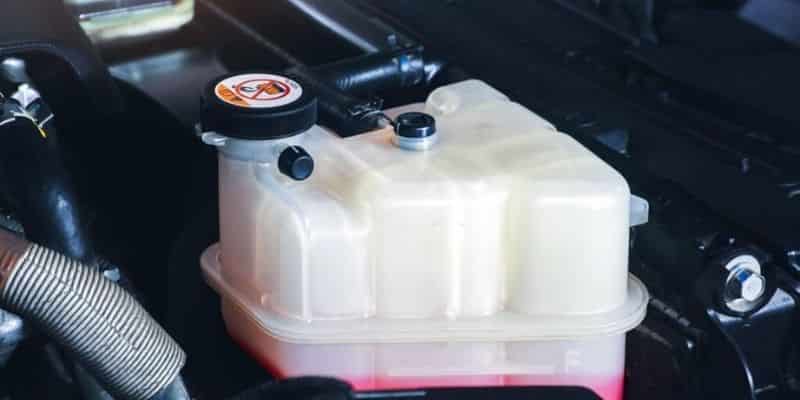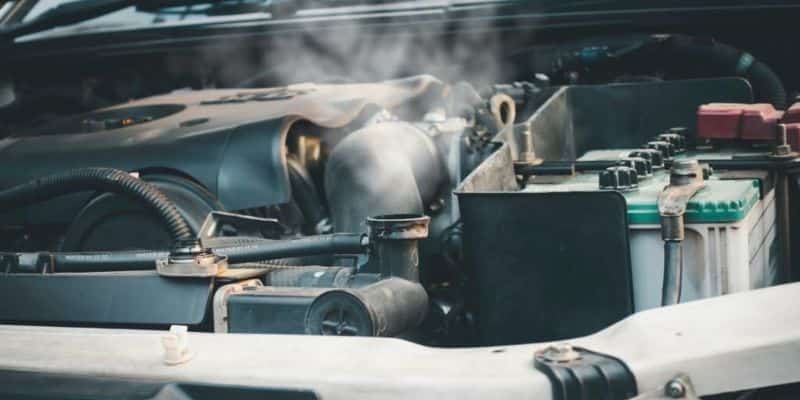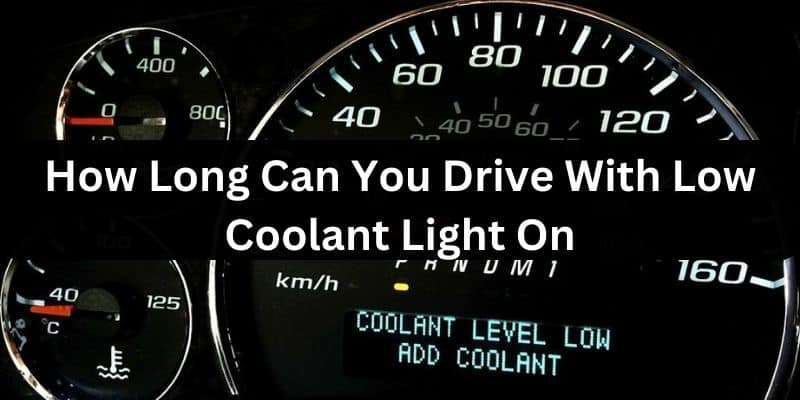A professional driver always monitors the dashboard warning lights to know whether there is any problem in the drive. Similarly, among the other warning signs on the dashboard, there is a “low coolant” light to keep a check on the coolant level in your car engine.
This low coolant warning light not only monitors the coolant level in the engine radiator but also helps to save the car engine from serious damage by engine overheating.
It is not normal when the coolant warning light is on as ignoring this could lead to the engine ceasing by overheating damage. However, it’s telling you that your car is running without coolant, and the coolant level is absolutely lower than the optimal level.
In this article, we will explore what is low coolant light and how it works. Additionally, you will learn how long can you drive with a low coolant light on without damaging your car engine. So, let’s begin by learning how the low coolant light works.
How Does the Low Coolant Light Work?
The “Low Coolant” light in your vehicle functions as a critical early warning system, helping you avoid potential engine damage. This warning light relies on a simple mechanism to warn you when there’s a problem with your engine’s coolant level.
The coolant light mechanism depends on a sensor placed within your engine’s cooling system. This sensor continuously monitors the level of coolant circulating throughout the system.
Coolant plays a pivotal role in regulating your engine’s temperature, preventing it from overheating. When the coolant level drops below a predefined threshold, the sensor detects this change.
Once the sensor identifies the low coolant level, it triggers the “Low Coolant” warning light on your vehicle’s dashboard. This illuminating signal serves as a clear and immediate indication that there’s an issue with the coolant level in your engine. It provokes you to find the cause of the low coolant and take necessary measures to address it promptly.
What Does It Mean When the Low Coolant Light Comes On?
When the “Low Coolant” light turns on in your vehicle’s dashboard, it indicates a potential issue with your engine’s cooling system. Understanding what this warning means is essential for maintaining your vehicle’s health.
- Low Coolant Level: The most common reason for the “Low Coolant” light to come on is a decreased coolant level in your engine’s cooling system. When the level of coolant drops below a certain threshold, it can no longer effectively dissipate heat, putting your engine at risk of overheating. Thus, when you see the “Low Coolant” light, it’s a clear indication that your engine might not have enough coolant mixture to operate safely.
- Potential Leaks: Another interpretation of the “Low Coolant” light coming on is that there may be a coolant leak in your vehicle’s cooling system. Coolant leaks can occur from various points in the system, such as hoses, the radiator, the water pump, or even the engine itself. These leaks can be gradual and challenging to detect visually. However, the “Low Coolant” light acts as an early warning sign of low coolant. Ignoring this warning could lead to more severe issues, so it’s essential to investigate the source of the low coolant promptly.

In essence, when the coolant warning light illuminates, it informs you that either the coolant level in your engine is too low or there may be a coolant leak. Either way, it’s a signal to take action to prevent potential engine damage and maintain your vehicle’s overall performance.
Can You Drive with the Low Coolant Light On?
No, it’s not safe to drive your car when the low coolant light turns on. Whether you are driving on a highway or in slow acceleration, you need to pull over as soon and turn off your engine.
Driving with an engine coolant light on could get you in serious trouble like engine overheating, engine head gasket being blown, and many others. The best practice to fix the low engine overheating is adding the engine coolant timely and monitoring the coolant leaks.
How Long Can You Drive with Low Coolant Light On?
The exact duration you can drive with the low coolant light on varies depending on several factors, such as the severity of the coolant loss and the specific make and model of your vehicle. However, it is generally advised to address the issue immediately and not drive for an extended period with the low coolant light illuminated.
Some professionals also advised that you can drive your car with low coolant for a few days as long as the coolant level is above the minimum level. But the wise decision is to not take the risk and add up the best coolant compatible with your car as soon as possible.
Here are some key factors to consider whether finding if you can drive your car without coolant or not:
- Coolant Level: The amount of time you can continue driving with this warning light on depends on how quickly your engine consumes coolant. Some vehicles have larger cooling systems and can run for a bit longer with a low coolant level, while others may deplete their coolant more rapidly.
- Driving Conditions: Your driving conditions play a significant role. If you’re driving in hot weather or stop-and-go traffic, your engine is more likely to heat up quickly. This can accelerate coolant consumption and increase the risk of overheating. In contrast, if you’re driving on a cooler day at a consistent speed, you may have a bit more time before the engine becomes critically hot.
- Temp Guage Monitoring: Whether it is not advised to drive the car with low coolant but if you choose to do so, it’s essential to monitor your engine’s temperature gauge closely. If you notice the gauge entering the danger zone, it’s time to pull over, turn off the engine, and allow it to cool down before proceeding. Continuing to drive with an overheated engine can lead to severe damage.

What to Do When the Low Coolant Light Comes On?
When the “Low Coolant” light comes on in your vehicle, it’s essential to take immediate action to prevent potential engine damage and ensure your safety on the road:
- Pull Over Safely: When the coolant warning light turns on, the first step is to pull over to a safe location. This allows you to assess the situation without the distraction of driving.
- Check Coolant Level: Once safely parked, pop the bonnet of your car and allow the engine to cool down for a few minutes. Then, check the coolant reservoir or radiator to gauge the coolant level. If it’s significantly low, you need to add coolant to bring it back to the recommended level. Be cautious when opening the radiator cap, as it can release hot steam.
- Seek Professional Help: While adding coolant may resolve the immediate issue, it’s essential to address the underlying cause. If you’re unsure why the coolant level was low, or if you suspect a leak or other cooling system problem, it’s advisable to seek assistance from a mechanic or a trusted automotive service provider. They can diagnose and repair any issues to prevent future occurrences.
- Do Not Overheat: You need to always keep an eye on the dashboard lights, especially on the engine temperature gauge if it starts to climb into the danger zone, turn off the engine immediately and allow it to cool before continuing. Driving with an overheated engine can cause severe damage.
What happens if I run my car without coolant?
Ignoring coolant warning signs can have serious consequences, leading to costly repairs and compromising your safety on the road. The major damages of low coolant are:
- Engine Overheating: One of the immediate consequences of low coolant is engine overheating. Coolant plays a vital role in regulating the engine’s temperature. When it’s too low, the engine can quickly reach excessive temperatures, leading to damage to various components, including the cylinder head gasket, engine block, and more. Repairing these damages can be expensive.
- Increased Risk of Breakdown: Low coolant levels often indicate an underlying issue, such as a coolant leak. Ignoring this warning sign can result in a breakdown, potentially leaving you stranded on the road. Breakdowns can be inconvenient and may lead to towing expenses and further repair costs.

Furthermore, driving with an overheating engine can cause severe damage and pose safety risks. An overheated engine may lead to a loss of power, which can be dangerous, especially in traffic or on highways.
How To Prevent Low Coolant Damage To The Engine?
To prevent the consequences of driving your car when coolant is low, you need to have regular checkups:
- Check Coolant before a ride: Make it a habit to check your coolant levels regularly, especially before embarking on long journeys. Your vehicle’s owner’s manual will provide guidance on how to do this safely. A visual inspection of the coolant reservoir should give you an idea of whether the level is where it should be.
- Scheduled Maintenance: Follow your vehicle manufacturer’s recommended maintenance schedule. This includes routine checks by a qualified mechanic who can assess not only coolant levels but also the overall health of your cooling system. They can identify and address any leaks or issues before they become major problems.
What Causes Antifreeze To Be Low?
Antifreeze, also known as coolant, can become low due to several reasons, including:
- Coolant Leak: The most common cause is a coolant leak in the cooling system. This can happen due to worn-out hoses, a damaged radiator, a faulty water pump, or a deteriorating gasket. These issues can lead to the gradual loss of coolant over time.
- Evaporation: In some cases, coolant can slowly evaporate from the system over an extended period. This is more common in older vehicles with aging components.
- Overheating Events: Excessive engine overheating can cause the coolant to boil and escape through the overflow reservoir, leading to low levels. Overheating can result from various issues, such as a malfunctioning thermostat or a blocked radiator.
FAQs
Can I drive 15 minutes with no coolant?
If your engine starts from a cold state and you drive gently without stressing the engine, you may be able to manage a short 15-minute trip without coolant.
How serious is low coolant?
Low coolant is a serious issue that can lead to engine damage and overheating if not addressed. Insufficient coolant levels can hinder the engine’s ability to regulate temperature, potentially causing costly repairs.
What if coolant is below min after driving?
If the coolant level goes below the minimum level then you should immediately stop your car and turn off your car engine to prevent damages like overheating.
How much coolant loss is normal as part of day-to-day use?
A small amount of coolant loss over time is considered normal due to evaporation and minor seepage. However, significant or sudden coolant loss typically indicates a problem that needs attention. It’s essential to monitor the coolant level regularly and investigate any noticeable decreases.
What can I use as a temporary coolant?
In an emergency situation, you can use plain water as a temporary coolant substitute. However, it’s crucial to replace it with the appropriate coolant solution as soon as possible to maintain your engine’s proper function and prevent damage.
Conclusion
Paying attention to the low coolant light in your vehicle is crucial for preserving the health and longevity of your engine. Ignoring this warning can lead to serious consequences, including overheating, engine damage, and costly repairs. Therefore, it’s essential to take immediate action when the low coolant light comes on.
Preventive maintenance, such as regularly checking and topping up coolant levels, is a simple yet effective way to ensure that you don’t find yourself in a situation where you need to drive with low coolant. Addressing coolant issues promptly can save you from the headaches and expenses associated with engine problems.

Joseph Morgan has decades of automotive experience. The Detroit native started restoring classics in the 1970s. He owned a vintage repair shop and authored articles for car magazines. With a 1965 Mustang fastback of his own, Joseph now shares advice through his YouTube channel. From engine swaps to rust repair, his expertise helps preserve automotive history.
